DMAIC is a structured, five-phase process improvement methodology used in Six Sigma to identify problems, eliminate root causes, and achieve lasting results. It stands for Define, Measure, Analyze, Improve, and Control.

DMAIC provides a step-by-step approach for improving existing processes by identifying problems, analyzing data, implementing solutions, and ensuring lasting results. Each phase plays a critical role in solving process challenges and boosting operational performance.
What Does DMAIC Stand For?
DMAIC is the foundation of Lean Six Sigma process improvement. Each phase builds upon the previous one, providing a structured, data-driven approach to solving problems, reducing variation, and achieving lasting operational excellence. DMAIC is one of the core methods used in the broader Six Sigma methodology.
- Define – Identify the problem and project goals.
Measure – Collect data to understand the current state.
Analyze – Identify root causes of inefficiencies or defects.
Improve – Implement targeted solutions.
Control – Sustain improvements over time.
The Five Phases of DMAIC
The DMAIC framework consists of five structured phases: Define, Measure, Analyze, Improve, and Control. Each phase plays a critical role in solving problems and driving process improvements.
The DMAIC process provides a step-by-step method for solving problems and improving quality.
| Phase | Purpose |
|---|---|
| Define | Identify the problem and set project goals based on customer needs. |
| Measure | Collect data to establish current process performance baselines. |
| Analyze | Identify root causes of inefficiencies or defects through data analysis. |
| Improve | Implement targeted solutions to address verified root causes. |
| Control | Monitor the improved process and sustain gains over time. |
Let’s take a closer look at each of the five DMAIC phases, starting with Define.
Define Phase
The Define phase sets the foundation for a successful project. Teams clearly identify the problem, define the project goals, outline the project scope, and understand customer requirements. Key activities include drafting a Project Charter and aligning leadership expectations. Selecting a meaningful but manageable project is crucial for success.
Key tools: Project Charters, SIPOC Diagrams (Suppliers, Inputs, Process, Outputs, Customers).
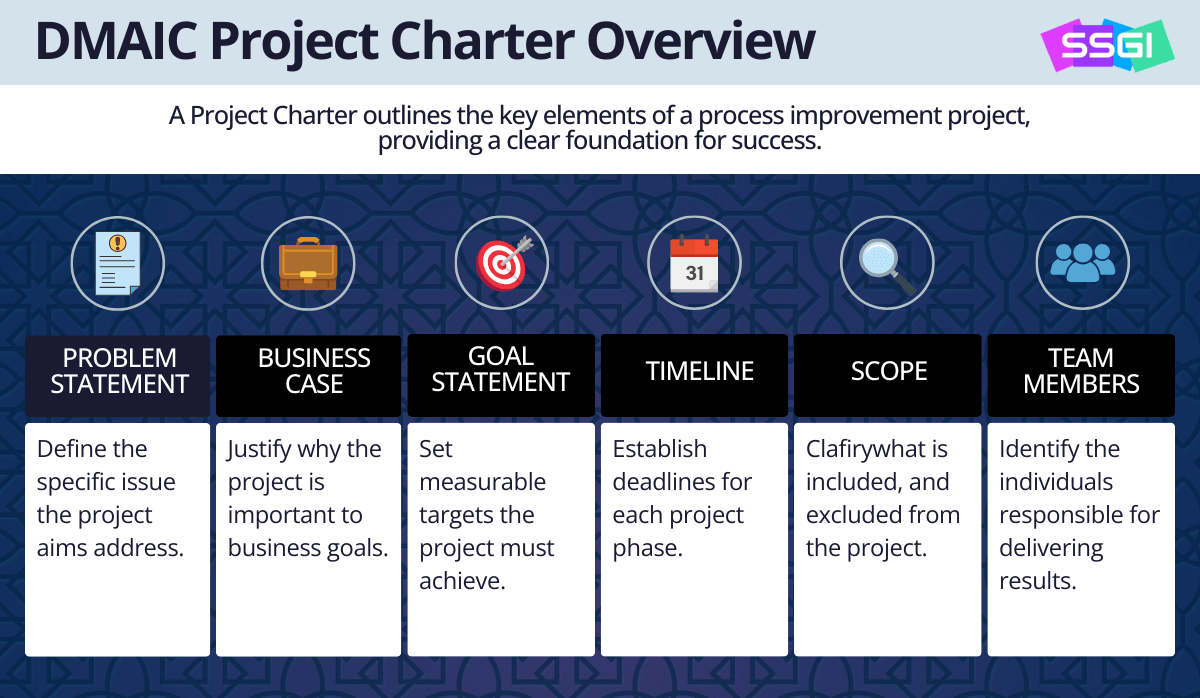
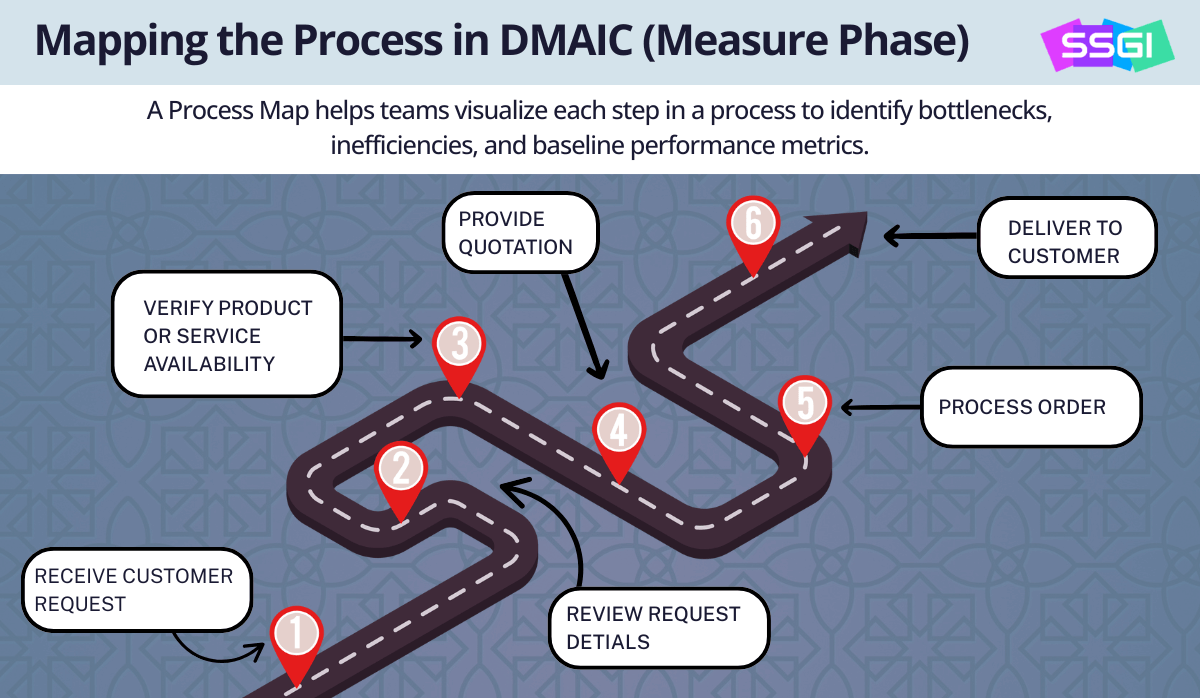
Measure Phase
In the Measure phase, teams collect data to establish a clear understanding of current process performance. This involves identifying critical-to-quality (CTQ) metrics, developing data collection plans, creating baseline measurements, and mapping existing processes. Accurate data provides the basis for informed analysis and decision-making.
Key tools: Data Collection Plans, Process Maps, Check Sheets.
Analyze Phase
The Analyze phase focuses on identifying the root causes of problems or inefficiencies. Teams use tools like Fishbone diagrams, Pareto charts, and statistical analysis to pinpoint sources of variation or defects. Validating root causes ensures that solutions are targeted at the true issues, not just symptoms.
Key tools: Root Cause Analysis (Fishbone diagrams), Pareto Charts, Regression Analysis.
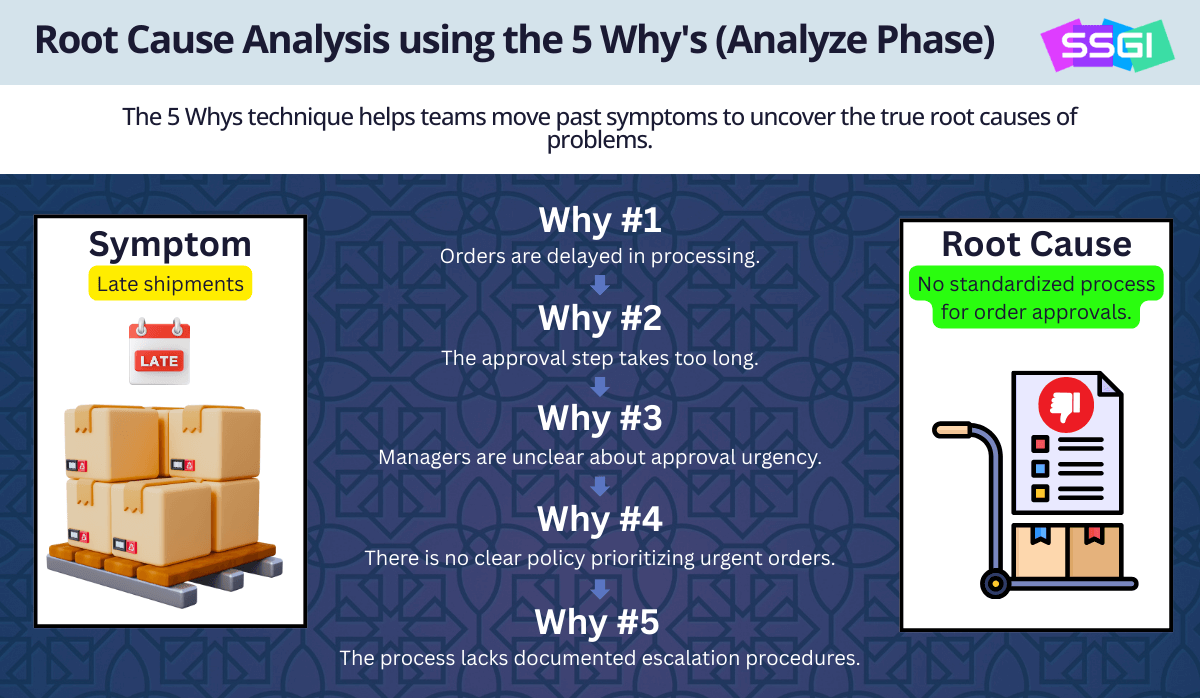
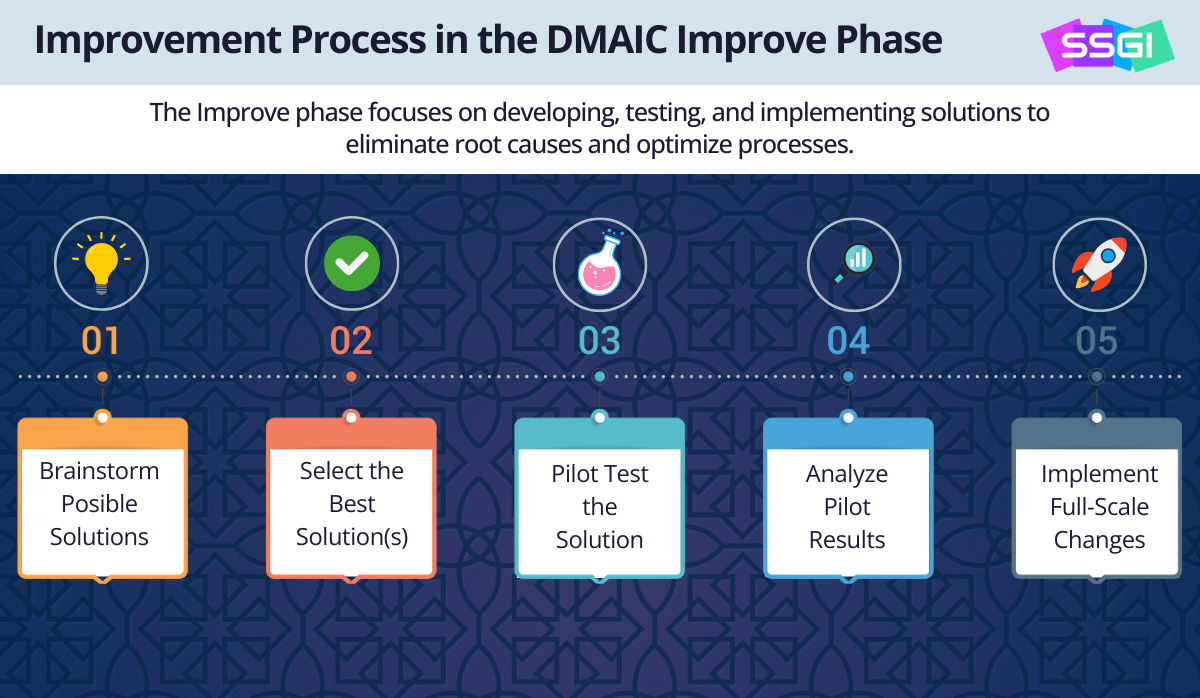
Improve Phase
During the Improve phase, teams develop and implement solutions that address the verified root causes. This includes brainstorming ideas, piloting changes on a small scale, and measuring the impact of improvements. Successful solutions are then deployed fully, resulting in measurable gains in efficiency, quality, or customer satisfaction.
Key tools: Brainstorming sessions, Pilot Testing, Solution Selection Matrix.
Control Phase
The Control phase ensures that improvements are sustained over time. Teams establish monitoring plans, implement control charts, standardize new procedures, and assign process ownership. Regular review and monitoring help prevent regression and promote continuous performance excellence.
Key tools: Control Charts, Standard Operating Procedures (SOPs), Monitoring Plans.
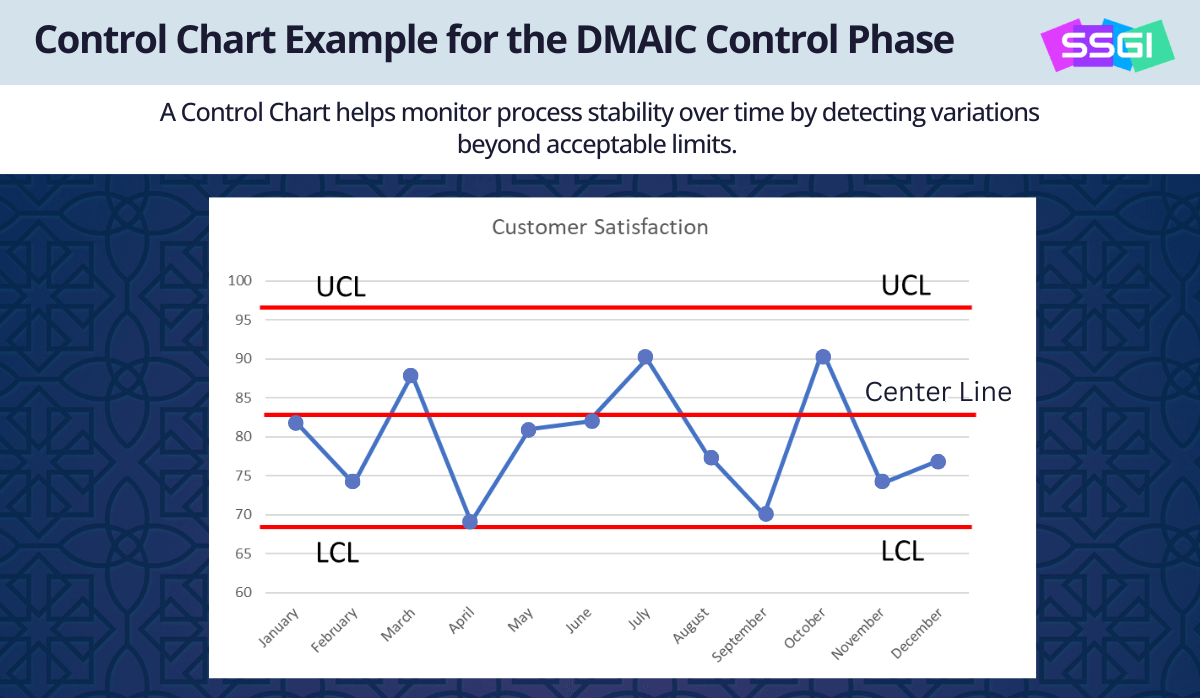
How DMAIC Is Applied in Different Industries
While the DMAIC structure is universal, its real power comes from flexible application across diverse fields. Below is a comparison of how each phase is applied in healthcare vs. manufacturing.
| DMAIC Phase | Healthcare Example | Manufacturing Example |
|---|---|---|
| Define | Reduce patient wait times in the emergency room | Decrease defects in an assembly line |
| Measure | Collect data on patient check-in to triage times | Measure defect rates per 1,000 units |
| Analyze | Identify delays caused by manual charting | Analyze root causes for frequent machine breakdowns |
| Improve | Implement electronic health records (EHR) for faster intake | Adjust equipment maintenance schedule to prevent failures |
| Control | Monitor patient throughput metrics monthly | Track defect rates using control charts to ensure improvements are sustained |
Why it matters: While the structure of DMAIC is universal, its application is highly industry-specific. This flexibility is what makes DMAIC so effective in solving a wide range of organizational problems — from hospitals to factories.
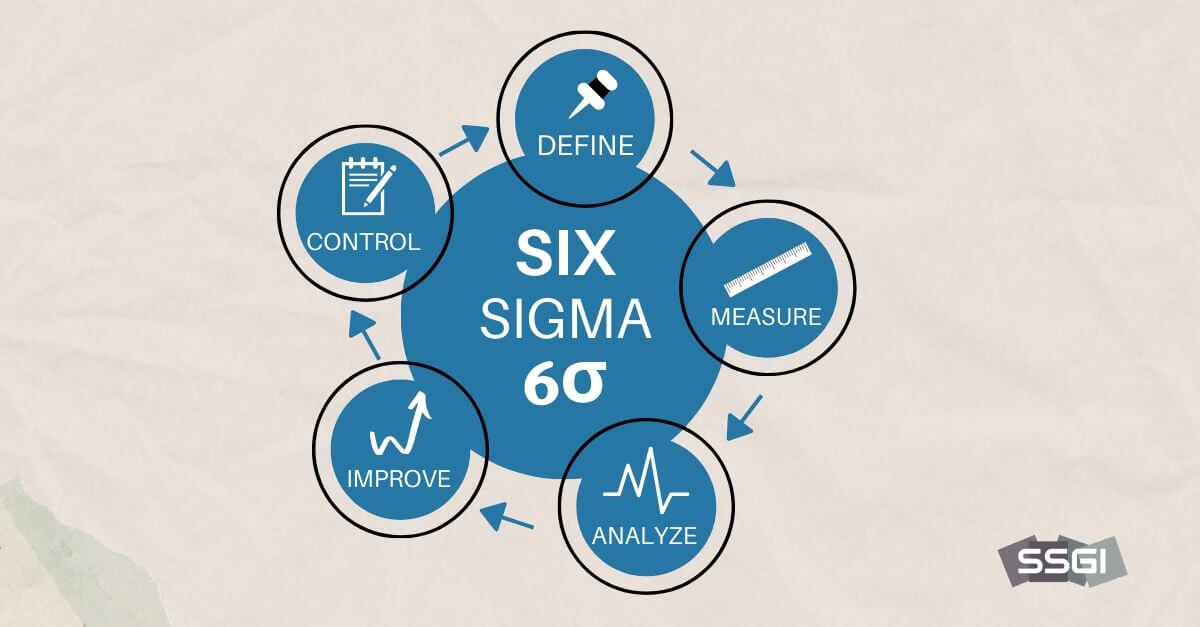
Why is DMAIC Important?
DMAIC is critical because it provides a structured, repeatable framework for solving business problems and improving process performance. By following its five phases, organizations can reduce waste, eliminate defects, and enhance customer satisfaction across a wide range of industries.
Beyond just solving immediate issues, DMAIC drives measurable results and promotes a culture of continuous improvement. Its disciplined approach ensures that improvements are based on data, not assumptions, leading to sustainable operational efficiency and long-term success.
For a deeper look at how Lean Six Sigma builds on DMAIC, visit our Lean Six Sigma overview.
Tools Commonly Used in DMAIC
Throughout each phase of the DMAIC process, Six Sigma professionals use a variety of tools to analyze problems, uncover root causes, and sustain improvements. These tools help teams apply data-driven decision-making at every step, ensuring that process changes are based on objective evidence rather than assumptions.
Key tools used within DMAIC include:

Pareto Charts
Helps prioritize problem areas by showing which causes contribute most significantly to defects or inefficiencies.
Fishbone Diagrams (Cause-and-Effect Diagrams)
Used during the Analyze phase to visually map out potential root causes of a problem.
Process Mapping
Creates a detailed visual flow of a process, helping teams identify inefficiencies, redundancies, or gaps.
Value Stream Mapping
A Lean tool that provides a high-level view of how value flows through a process, used to spot and eliminate waste.
Control Charts
Used in the Control phase to monitor process stability and detect variations over time.
Failure Mode and Effects Analysis (FMEA)
A proactive tool used to identify potential failure points in a process and assess their impact before they occur.
Real-World DMAIC Project Examples in Healthcare and Manufacturing
Below are two real-world DMAIC examples demonstrating how this methodology can be used to improve operations across industries. Whether in healthcare or manufacturing, DMAIC provides a data-driven framework for solving complex process challenges.
🏥 DMAIC Example in Healthcare: Reducing Emergency Room Wait Times
A large regional hospital used DMAIC to reduce ER patient wait times. After defining the problem and measuring the average intake-to-treatment time, they found bottlenecks during nurse assessments. By analyzing workflows, the team identified redundant data entry as a major issue. The improvement phase included implementing a streamlined digital intake form. Over the next 90 days, average wait times dropped by 22%, and staff satisfaction scores increased.
🏭 DMAIC Example in Manufacturing: Reducing Rework on the Assembly Line
An auto parts manufacturer used DMAIC to reduce rework on its brake pad production line. After measuring error rates and root causes, they discovered a calibration issue with a specific machine. Adjustments in the Improve phase led to a 30% reduction in rework, saving $150,000 annually.
Want to lead projects like these?
Start with our Lean Six Sigma Green Belt Certification →FREQUENTLY ASKED QUESTIONS ABOUT DMAIC
What is DMAIC?
DMAIC is a structured, five-phase process improvement methodology used in Six Sigma to identify problems, eliminate root causes, and achieve lasting results. It stands for Define, Measure, Analyze, Improve, and Control.
What are the five phases of DMAIC?
The five phases of DMAIC are Define, Measure, Analyze, Improve, and Control.
Is DMAIC the same as Six Sigma?
No, DMAIC is the core process improvement framework used within Six Sigma. Six Sigma is the broader methodology focused on reducing defects, while DMAIC provides the step-by-step approach to improve existing processes.
Is DMAIC the same as Kaizen?
No, DMAIC and Kaizen are different. DMAIC is a structured, five-phase problem-solving process used in Six Sigma, while Kaizen is a philosophy focused on continuous, incremental improvements over time.
What is the difference between DMAIC and PDCA?
DMAIC is data-driven and more statistical, while PDCA is simpler and more iterative.
What industries use DMAIC?
Healthcare, manufacturing, finance, education, technology, IT, government, and more.
Is DMAIC only used in Six Sigma?
While DMAIC originated with Six Sigma, it is now used broadly across all continuous improvement efforts.
How long does a typical DMAIC project take?
Depending on scope, DMAIC projects can range from a few weeks to several months.
What is the main purpose of DMAIC?
DMAIC provides a structured, data-driven approach to problem-solving and process improvement. Its primary purpose is to identify the root causes of inefficiencies, implement targeted solutions, and sustain long-term improvements across business processes.
Can DMAIC be used outside of manufacturing?
Yes. Although DMAIC originated in manufacturing, it is now widely applied across industries such as healthcare, finance, education, technology, and government. Any organization looking to reduce defects, streamline operations, or improve service quality can benefit from DMAIC.
What tools are most commonly used during DMAIC projects?
Key tools include Fishbone Diagrams, Process Mapping, Control Charts, Pareto Charts, Value Stream Mapping, and Failure Mode and Effects Analysis (FMEA). These tools help teams analyze processes, identify root causes, implement improvements, and maintain process control.
#1 in Process Improvement Training | McGraw Hill Award Winning Instructor | Baldrige Foundation & Project Management Institute Partner














